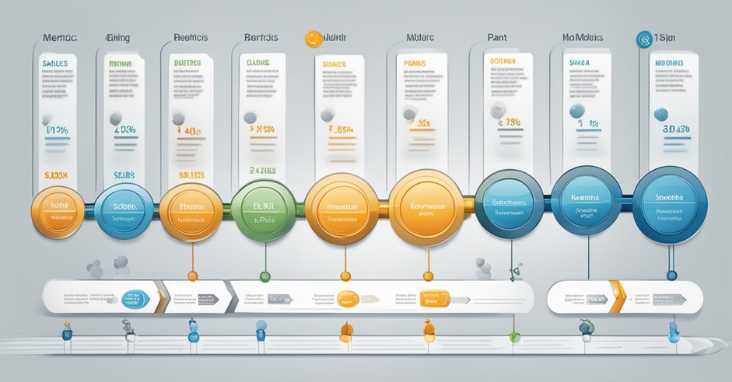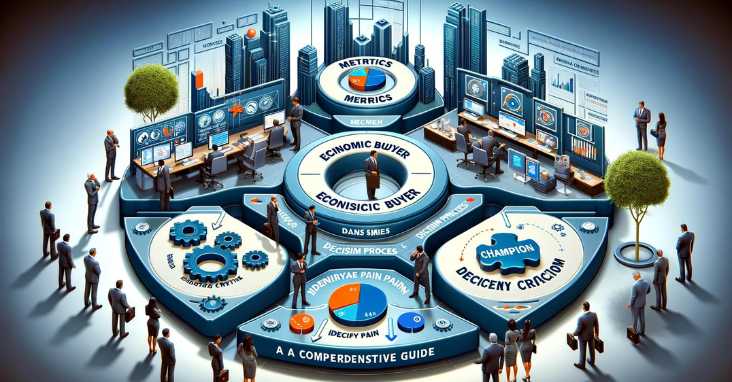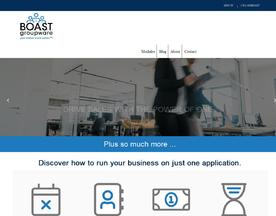What is meddic sales process ? MEDDIC sales process is a methodology focusing on Metrics, Economic Buyer, Decision Criteria, Identify Pain, and Champion to enhance deal qualification.
The MEDDIC sales process is a methodology that helps sales teams increase their chances of closing deals by focusing on the most promising leads. MEDDIC stands for Metrics, Economic Buyer, Decision Criteria, Decision Process, Identify Pain, and Champion. This process is designed to help salespeople identify the most qualified leads, understand their needs and goals, and tailor their pitch accordingly.

Understanding MEDDIC is crucial for sales teams looking to improve their performance. By following this process, salespeople can ensure that they are targeting the right prospects, asking the right questions, and addressing the most pressing pain points. The process is also designed to help salespeople build strong relationships with their prospects, which can lead to long-term partnerships and increased revenue.
Implementing the MEDDIC checklist can be challenging, but the benefits are well worth the effort. By integrating this process into their sales strategy, teams can improve their efficiency, close more deals, and ultimately increase their revenue. To learn more about the MEDDIC sales process and how it can benefit your team, check out this comprehensive guide from Salesforce.
Key Takeaways
- The MEDDIC sales process is a methodology that helps sales teams increase their chances of closing deals by focusing on the most promising leads.
- Understanding MEDDIC is crucial for sales teams looking to improve their performance.
- By implementing the MEDDIC checklist, teams can improve their efficiency, close more deals, and ultimately increase their revenue.
Understanding MEDDIC
MEDDIC is a sales qualification framework that is widely used by sales teams to increase their chances of closing deals. The MEDDIC sales process was developed by Dick Dunkel and Jack Napoli in the early 1990s. This framework has been successful in helping sales teams to increase their win rates and achieve their sales targets.
Origins of MEDDIC
The MEDDIC sales process was first introduced by Dick Dunkel, who was the Vice President of Sales at PTC, a software company. Dunkel was looking for a way to improve the sales process and increase the company’s revenue. He developed the MEDDIC framework, which stands for Metrics, Economic Buyer, Decision Criteria, Decision Process, Identify Pain, and Champion.
Jack Napoli, who was also working at PTC at the time, helped to refine the MEDDIC framework and make it more effective. Napoli was responsible for training the sales team on the MEDDIC sales process, and he played a key role in its success.
MEDDIC as a Sales Qualification Framework
The MEDDIC sales process is a comprehensive framework that helps sales teams to qualify leads and close deals. The framework is based on six key elements, which are:
- Metrics: Sales teams need to understand the metrics that are important to the customer. This includes metrics such as revenue, cost savings, and ROI.
- Economic Buyer: Sales teams need to identify the economic buyer, who is the person responsible for making the buying decision.
- Decision Criteria: Sales teams need to understand the decision criteria that the customer will use to make their buying decision.
- Decision Process: Sales teams need to understand the decision-making process that the customer will go through.
- Identify Pain: Sales teams need to identify the pain points that the customer is experiencing and how their product or service can help to alleviate those pain points.
- Champion: Sales teams need to identify a champion within the customer’s organization who can help to promote their product or service and influence the buying decision.
By using the MEDDIC sales process, sales teams can qualify leads more effectively and increase their chances of closing deals. The framework helps sales teams to focus on the needs of the customer and provide them with the information they need to make an informed buying decision.
To learn more about the MEDDIC sales process, check out this article by SalesHacker, which provides a detailed overview of the framework and its benefits.
Components of the MEDDIC Sales Process
The MEDDIC sales process is a widely used framework for sales teams to follow in order to increase their chances of closing deals. It is an acronym that stands for Metrics, Economic Buyer, Decision Criteria, Decision Process, Identify Pain, and Champion. Each of these components plays a crucial role in the sales process, and understanding them is key to success.
Metrics
Metrics are a vital component of the MEDDIC sales process. Sales teams must understand the metrics that are important to their customers, such as ROI, to effectively demonstrate the value of their product or service. By understanding these metrics, sales teams can tailor their pitch and show how their solution will help the customer achieve their goals.
Economic Buyer
The economic buyer is the person or group that has the final say in purchasing decisions. Understanding who the economic buyer is and their priorities is important for sales teams to effectively close deals. This involves identifying the decision-making process and the key stakeholders involved.
Decision Criteria
Understanding the decision criteria is crucial for sales teams to effectively position their solution. By understanding what factors are most important to the customer, sales teams can tailor their pitch and show how their solution meets those criteria.
Decision Process
The decision process is the series of steps that a customer goes through before making a purchasing decision. Understanding this process is important for sales teams to effectively navigate the sales cycle. By understanding the decision process, sales teams can identify potential roadblocks and address them proactively.
Identify Pain
Identifying pain points is a critical component of the MEDDIC sales process. Sales teams must understand the challenges that their customers are facing in order to position their solution effectively. By identifying pain points, sales teams can demonstrate how their solution can help alleviate those challenges.
Champion
A champion is someone within the customer organization who is an advocate for the sales team and their solution. Identifying a champion is important for sales teams to effectively navigate the decision-making process and increase their chances of closing a deal.
One external resource that provides more information on the MEDDIC sales process is HubSpot’s article on the topic.
Implementing the MEDDIC Checklist
The MEDDIC sales process is a proven methodology that helps sales teams qualify prospects and close deals more efficiently. The MEDDIC checklist is an acronym that stands for Metrics, Economic Buyer, Decision Criteria, Decision Process, Identify Pain, and Champion. Implementing this checklist can help sales reps identify key decision-makers, understand their needs, and close deals faster.
Identifying the Economic Buyer
One of the critical steps in the MEDDIC sales process is identifying the economic buyer. The economic buyer is the person who has the authority to make the final purchasing decision. This person is typically a high-level executive who has the authority to allocate budget and resources. To identify the economic buyer, sales reps must ask questions that help them understand the prospect’s organizational structure. They should also research the company’s leadership team and identify the person who has the final say on purchasing decisions.
Understanding Decision Criteria
Understanding the prospect’s decision criteria is another crucial step in the MEDDIC sales process. Decision criteria are the factors that the prospect considers when making a purchasing decision. These factors can include price, features, quality, and support. Sales reps must ask questions that help them understand the prospect’s decision criteria and tailor their pitch accordingly.
Mapping the Decision Process
Mapping the decision process is another key step in the MEDDIC sales process. The decision process is the series of steps that the prospect takes to make a purchasing decision. Sales reps must ask questions that help them understand the decision process and identify the key decision-makers. They should also understand the prospect’s timeline and any other factors that could impact the decision process.
Recognizing Pain Points
Recognizing pain points is another critical step in the MEDDIC sales process. Pain points are the problems or challenges that the prospect is facing. Sales reps must ask questions that help them understand the prospect’s pain points and how their solution can help solve them. They should also be prepared to provide examples of how their solution has helped other customers overcome similar challenges.
Establishing the Champion
Establishing the champion is the final step in the MEDDIC sales process. The champion is the person who advocates for the sales rep’s solution within the prospect’s organization. Sales reps must identify the champion early in the sales process and work to establish a strong relationship with them. They should also provide the champion with the information and resources they need to advocate for their solution effectively.
By implementing the MEDDIC checklist, sales reps can improve their sales process and close more deals. To learn more about the MEDDIC sales process, check out this article.
MEDDIC in Different Sales Stages

The MEDDIC sales process is a proven methodology that helps sales teams to identify and close deals with qualified leads. The process is divided into different stages, each with its own set of criteria and goals. Here’s how MEDDIC can be applied in different sales stages:
Lead Qualification
The first stage of the MEDDIC process is lead qualification. This stage involves identifying potential leads and determining whether they are a good fit for your product or service. To qualify a lead, you need to evaluate their needs, budget, decision-making power, and timeline.
MEDDIC provides a framework for lead qualification that includes the following criteria:
- Metrics: What are the lead’s specific goals and objectives?
- Economic Buyer: Who is the decision-maker and what is their budget?
- Decision Criteria: What factors will influence the decision to buy?
- Decision Process: What is the timeline for making a decision?
- Identify Pain: What are the lead’s pain points and how can your product or service solve them?
- Champion: Who is the lead’s internal advocate?
By using these criteria, you can identify leads that are most likely to convert into paying customers.
Opportunity Analysis
Once you have qualified a lead, the next stage is opportunity analysis. This stage involves gathering more information about the lead, including their specific needs and how your product or service can meet those needs.
MEDDIC provides a framework for opportunity analysis that includes the following criteria:
- Metrics: What are the lead’s specific goals and objectives?
- Economic Buyer: Who is the decision-maker and what is their budget?
- Decision Criteria: What factors will influence the decision to buy?
- Decision Process: What is the timeline for making a decision?
- Identify Pain: What are the lead’s pain points and how can your product or service solve them?
- Champion: Who is the lead’s internal advocate?
- Competition: What other solutions are the lead considering?
- Paper Process: What is the procurement process for the lead’s organization?
By using these criteria, you can develop a tailored solution that meets the lead’s specific needs and positions your product or service as the best option.
Closing Deals
The final stage of the MEDDIC process is closing deals. This stage involves negotiating with the lead and finalizing the sale. To successfully close a deal, you need to understand the lead’s decision-making process and address any objections or concerns they may have.
MEDDIC provides a framework for closing deals that includes the following criteria:
- Metrics: What are the lead’s specific goals and objectives?
- Economic Buyer: Who is the decision-maker and what is their budget?
- Decision Criteria: What factors will influence the decision to buy?
- Decision Process: What is the timeline for making a decision?
- Identify Pain: What are the lead’s pain points and how can your product or service solve them?
- Champion: Who is the lead’s internal advocate?
- Competition: What other solutions are the lead considering?
- Paper Process: What is the procurement process for the lead’s organization?
- Power: What is the lead’s level of influence within their organization?
By using these criteria, you can address the lead’s concerns and close the deal on favorable terms.
For more information on the MEDDIC sales process, check out this article, which provides a detailed overview of the methodology and its benefits.
Integrating MEDDIC with CRM Systems

MEDDIC is a sales process that helps sales teams qualify their leads and opportunities effectively. By integrating MEDDIC with CRM systems, sales teams can manage their data more efficiently and track their progress towards closing deals. This section will discuss the benefits of integrating MEDDIC with CRM systems and how it can help sales teams improve their sales processes.
Data Management
Integrating MEDDIC with CRM systems can help sales teams manage their data more effectively. By using a CRM system, sales teams can keep track of their leads, opportunities, and customer interactions in one centralized location. This can help sales teams stay organized and ensure that they are working on the most important deals.
In addition, by using a CRM system, sales teams can ensure that their data is up-to-date and accurate. This can help sales teams make better decisions and improve their sales processes over time. By integrating MEDDIC with CRM systems, sales teams can ensure that they are using the most relevant data to qualify their leads and opportunities.
Tracking and Reporting
Integrating MEDDIC with CRM systems can also help sales teams track their progress towards closing deals. By using a CRM system, sales teams can track their interactions with leads and opportunities, as well as the status of each deal. This can help sales teams identify potential roadblocks and take action to overcome them.
In addition, by using a CRM system, sales teams can generate reports that provide insights into their sales processes. This can help sales teams identify areas for improvement and make data-driven decisions. By integrating MEDDIC with CRM systems, sales teams can ensure that they are tracking their progress towards closing deals effectively.
Overall, integrating MEDDIC with CRM systems can help sales teams manage their data more effectively and track their progress towards closing deals. By using a CRM system, sales teams can ensure that they are using the most relevant data to qualify their leads and opportunities, and make data-driven decisions to improve their sales processes over time.
To learn more about integrating MEDDIC with CRM systems, check out this article from Salesforce, a high-authority resource on the topic.
Enhancing Sales Team Performance

In order to achieve sales success, it is important for sales reps to have a thorough understanding of the MEDDIC sales process. However, training on MEDDIC alone is not enough to ensure success. Sales professionals must also adopt best practices and strive for continuous improvement to enhance their performance and achieve their sales goals.
Training on MEDDIC
One of the most important steps in enhancing sales team performance is providing comprehensive training on MEDDIC. This includes educating sales reps on the various stages of the MEDDIC process and how to effectively apply it in their sales approach. It is also important to provide ongoing training and support to ensure that sales professionals are able to apply MEDDIC in real-world scenarios.
To supplement internal training, sales teams can also look to external resources for additional support. For example, the MEDDIC Academy offers a range of training courses and resources to help sales professionals master the MEDDIC process and achieve sales success.
Adopting Best Practices
In addition to training on MEDDIC, sales teams must also adopt best practices to enhance their performance. This includes understanding the unique needs and pain points of their target audience, developing effective sales strategies, and leveraging technology to streamline the sales process.
Sales professionals must also be willing to learn from their peers and industry experts to stay up-to-date on the latest trends and best practices. This can include attending industry conferences and networking events, as well as participating in online forums and discussion groups.
Continuous Improvement
Finally, sales teams must be committed to continuous improvement in order to achieve long-term success. This includes regularly evaluating their sales process, identifying areas for improvement, and implementing changes to optimize performance.
To support continuous improvement, sales teams can leverage tools and technologies such as CRM software and analytics platforms. These tools can provide valuable insights into sales performance and help sales professionals make data-driven decisions to improve their approach.
By focusing on training, best practices, and continuous improvement, sales teams can enhance their performance and achieve their sales goals. With the right tools and resources, sales professionals can master the MEDDIC sales process and drive sales success.
Here is a link to the MEDDIC Academy, a resource that offers training courses and resources to help sales professionals master the MEDDIC process and achieve sales success.
Challenges and Solutions in MEDDIC Implementation

MEDDIC is a proven sales methodology that has been widely adopted by many organizations. However, like any other methodology, it comes with its own set of challenges during implementation. In this section, we will discuss some of the common challenges that organizations face during MEDDIC implementation and provide solutions to overcome those challenges.
Common Objections
One of the most common objections to MEDDIC is that it is too rigid and does not allow for flexibility. Some sales reps believe that sticking to a strict process can limit their ability to adapt to unique situations and build relationships with customers. In reality, MEDDIC is a flexible framework that can be tailored to the unique needs of each customer.
Another common objection is that MEDDIC is too time-consuming and takes away from selling time. This objection can be addressed by ensuring that the MEDDIC process is streamlined and integrated into the sales process. By doing so, sales reps can save time and focus on selling while still following the MEDDIC framework.
Tailoring MEDDIC to Unique Needs
One of the key advantages of MEDDIC is that it can be tailored to the unique needs of each customer. However, this can also be a challenge during implementation. Sales reps may struggle to apply the framework to different industries, products, or customer segments.
To overcome this challenge, organizations should provide training and support to help sales reps tailor MEDDIC to their unique needs. This can include providing examples of how the framework has been applied in different industries or offering coaching to help sales reps apply the framework to specific customer segments.
Overcoming Implementation Hurdles
Implementing MEDDIC can also be challenging due to resistance from sales reps or lack of support from leadership. To overcome these hurdles, organizations should ensure that there is buy-in from all stakeholders, including sales reps, sales managers, and leadership.
Additionally, organizations should provide ongoing training and support to ensure that sales reps are comfortable with the MEDDIC framework and have the resources they need to be successful. This can include providing coaching, offering resources such as templates or checklists, and providing ongoing feedback and support.
In conclusion, while MEDDIC is a powerful sales methodology, it comes with its own set of challenges during implementation. By addressing common objections, tailoring the framework to unique needs, and providing ongoing training and support, organizations can overcome these challenges and successfully implement MEDDIC. For more information on MEDDIC, check out this resource.
Measuring Success and ROI

Measuring the success and return on investment (ROI) of the MEDDIC sales process is crucial for companies to determine the effectiveness of their sales strategy. By tracking key performance indicators (KPIs), companies can identify areas for improvement and optimize their sales process.
Key Performance Indicators (KPIs)
KPIs provide a way to measure the performance of the sales team and the effectiveness of the MEDDIC sales process. Some common KPIs for measuring success in MEDDIC sales include:
- Sales cycle length
- Win rate
- Deal size
- Lead conversion rate
By tracking these KPIs, companies can identify areas where the sales process can be improved and optimize their sales strategy for better results.
Revenue Growth
One of the most important metrics for measuring the success of the MEDDIC sales process is revenue growth. By tracking revenue growth over time, companies can determine whether their sales strategy is effective and whether they are achieving their revenue goals.
Cost Efficiency
Another important metric for measuring the success of the MEDDIC sales process is cost efficiency. By tracking the cost of sales and the cost per lead, companies can determine whether their sales strategy is cost-effective and whether they are getting a good return on investment.
To optimize cost efficiency, companies should focus on improving lead quality and reducing the cost of sales. This can be achieved through better targeting and qualification of leads, as well as by streamlining the sales process.
To learn more about measuring the success and ROI of the MEDDIC sales process, check out this article.
Advanced MEDDIC: MEDDPICC and MEDDPIC

MEDDPICC Methodology
MEDDIC is a well-known sales qualification process that helps sales reps to identify and close deals with high-value prospects. However, in some cases, the standard MEDDIC methodology may not be enough to handle complex sales situations. That’s where MEDDPICC comes in.
MEDDPICC is an advanced version of MEDDIC that includes two additional criteria: Competition and Decision Process. By adding these two elements to the standard MEDDIC framework, sales reps can gain a deeper understanding of the prospect’s buying process and the competitive landscape.
The MEDDPICC methodology is as follows:
- Metrics: What are the prospect’s key performance indicators (KPIs)?
- Economic Buyer: Who is the decision-maker with budget authority?
- Decision Criteria: What are the prospect’s decision-making criteria?
- Decision Process: What is the prospect’s decision-making process?
- Paper Process: What is the prospect’s procurement process?
- Identify Pain: What is the prospect’s pain point?
- Champion: Who is the internal advocate for the deal?
- Competition: Who are the competitors?
- Control: What is the sales rep’s plan to win the deal?
MEDDPIC Variations
MEDDPIC is another variation of the MEDDIC methodology that includes two additional criteria: Paper Process and Implementation Plan. By adding these two elements to the standard MEDDIC framework, sales reps can gain a deeper understanding of the prospect’s procurement process and the implementation plan.
The MEDDPIC methodology is as follows:
- Metrics: What are the prospect’s key performance indicators (KPIs)?
- Economic Buyer: Who is the decision-maker with budget authority?
- Decision Criteria: What are the prospect’s decision-making criteria?
- Decision Process: What is the prospect’s decision-making process?
- Identify Pain: What is the prospect’s pain point?
- Champion: Who is the internal advocate for the deal?
- Paper Process: What is the prospect’s procurement process?
- Implementation Plan: What is the prospect’s plan for implementing the solution?
- Control: What is the sales rep’s plan to win the deal?
Sales reps should choose the MEDDIC variation that best suits the prospect’s situation. By using an advanced qualification methodology like MEDDPICC or MEDDPIC, sales reps can increase their chances of closing complex deals.
For more information on MEDDPICC and MEDDPIC, check out this SalesHacker article.
Frequently Asked Questions

What are the key components of the MEDDIC sales process?
The MEDDIC sales process is a methodology that helps sales teams to identify and qualify leads effectively. The key components of the MEDDIC sales process are:
- Metrics
- Economic Buyer
- Decision Criteria
- Decision Process
- Identify Pain
- Champion
How does the MEDDIC scoring system enhance sales qualification?
The MEDDIC scoring system is a way to measure how well a prospect fits the criteria of the MEDDIC sales process. It enhances sales qualification by providing a clear framework for evaluating prospects based on their metrics, economic buyer, decision criteria, decision process, pain points, and champions. This allows sales teams to focus their efforts on the most promising leads, increasing their chances of success.
What are the differences between MEDDIC and MEDDPIC sales methodologies?
MEDDIC and MEDDPIC are both sales methodologies that focus on identifying and qualifying leads. The main difference between the two is that MEDDPIC includes an additional component, which stands for Paper Process, or the paperwork and legal aspects of closing a deal. MEDDIC, on the other hand, does not include this component.
How can MEDDIC sales training improve a sales team’s performance?
MEDDIC sales training can improve a sales team’s performance by providing them with a clear and effective framework for identifying and qualifying leads. It can also help them to develop better communication skills, build stronger relationships with prospects, and close deals more effectively. By implementing the MEDDIC sales process, sales teams can increase their win rates and improve their overall performance.
In what ways does the MEDDIC sales process differ from SPIN selling?
The MEDDIC sales process and SPIN selling are both methodologies for identifying and qualifying leads, but they differ in their approach. SPIN selling focuses on asking questions to uncover a prospect’s pain points and needs, while the MEDDIC sales process focuses on identifying a prospect’s metrics, economic buyer, decision criteria, decision process, pain points, and champions. The MEDDIC sales process is more comprehensive and provides a more structured approach to lead qualification.
Is obtaining a MEDDIC certification beneficial for sales professionals?
Obtaining a MEDDIC certification can be beneficial for sales professionals who want to improve their skills and knowledge of the MEDDIC sales process. It can help them to stand out from other sales professionals and demonstrate their expertise in lead qualification. However, it is important to note that certification alone does not guarantee success in sales. Sales professionals must also have strong communication skills, relationship-building abilities, and a deep understanding of their industry and market.
For more information on the MEDDIC sales process, check out this article by Sales Hacker.















